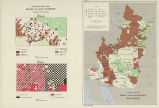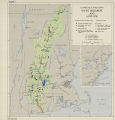| OCR Text |
Show This concept incorporates the doctrine that salvage waters accrue to the one who makes the salvage. It has been determined that the Colorado River and its tributaries lose water along their channels through evaporation and transpiration and that with smaller flows the losses will be smaller. Thus, if a given quantity of water is consumed some dis- tance upstream, the flow at Lee Ferry will be reduced by a smaller amount. Under the inter- pretation of "beneficial consumptive use" used by the States, except California and Nevada, the State in which the use is made is charged with that amount. Under the contention of California and Nevada, each individual diversion shall be measured and from that the return flow shall be subtracted. The effect of that use on a downstream point is not considered even when there may be a sizable dif- ference between the consumptive use on the proj- ect and depletion at a point downstream. This is a single project concept of diversion less return flow. The differences between Arizona and California center mainly on the relation to the Colorado of the Gila River, which flows entirely in New Mexico and Arizona and enters the Colorado very near the Mexican boundary. In Arizona's interpreta- tion the water of the Gila River is apportioned to the lower basin by article III (b) of the Colorado River Compact. California claims that the Gila River is not apportioned by article III (b) of the compact but is surplus or unapportioned water. Impartial studies which show the effect of all these separate contentions were not available in November 1950. Testimony at hearings before the Committee on Interior and Insular Affairs of the United States Senate, indicated that California esti- mates that the upper basin interpretation will profit upper basin States to the extent of 800,000 acre- feet a year. More than 1 million acre-feet annu- ally are represented in the differences between Ari- zona and California as to measurement of lower basin uses.3 These differences in interpretation are matters of considerable importance, because the compact was based on information which did not include lowest recorded flows on the stream. These all have occurred since 1929. Between 1931 and 1940 the 10-year flow at Lee Ferry was only 118 million * U. S. Congress. Senate. Committee on Interior and Insular Affairs. Central Arizona Project and Colorado River Water Rights. Hearings * * * 81st Cong., 1st sess., on S. 75 and S. J. Res. 4. Washington, Govern- ment Printing Office, 1949, p. 215. acre-feet. Assuming full consumptive use of the lower basin's share within the lower basin, only 43 million acre-feet, or 57 percent of its entitlement under article III (a) would be available to the upper basin during another equally intense drought.* Differences in distribution may be of national significance. The increment of crop production to be obtained from a given quantity of water is much greater in California and Arizona than in the upper basin States. Accordingly, allocation in one way or another can extend or restrict the produce to be obtained from water. The complexity of the issues can be partly illus- trated by table 8, drafted by representatives of the Bureau of Reclamation to illustrate differences in the points of view of Arizona and California. No difference of opinion between the United States and Mexico as to water allocation was in prospect in 1950. There are presently no known conflicts of signifi- cance among the upper basin States. Those States have entered into a compact which divides the water allocation of the upper basin among the separate States.6 Within this framework, only re- cently available, integrated water resources plan- ning can proceed. The Upper Colorado River Commission also provides an organizational focus for Federal-State cooperation in upper basin plan- ning and construction. On the other hand, there are real conflicts within the lower basin. There has been no allocation by State of the water due to the lower basin under the Colorado River Compact except as effected by the Boulder Project Act, the California Self-Limita- tion Statute, and the various water delivery con- tracts negotiated by the Secretary of the Interior. For all practical purposes, negotiation among the States toward such division was abandoned by 1950. There is apparently no disposition to deny New Mexico, Nevada, or Utah the use of water indicated by the Department of the Interior's re- port, The Colorado River,6 as representing those States' ultimate economic potential. As between Arizona and California, however, there are real differences. In California's view, Arizona is pres- ently using, or has obligated to projects now author- ized, her full entitlement of Colorado River system * Not allowing for storage. B Upper Colorado River Basin Compact, executed Oc- tober 11, 1948, and approved by Congress April 6, 1949, 63 Stat. 31. a H. Doc. 419, 80th Cong., 1st sess. 391 |


























































































































































































































































































































































































































































































































































































































































































































































































































































